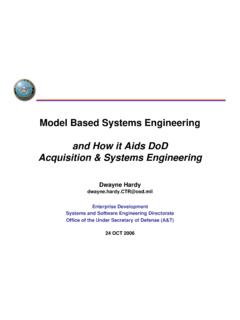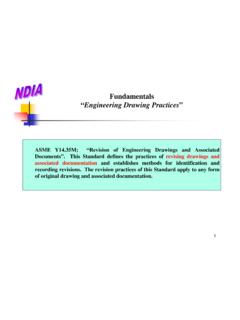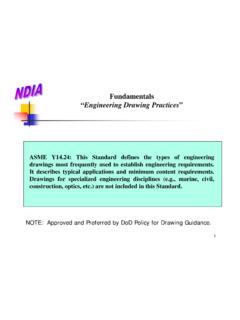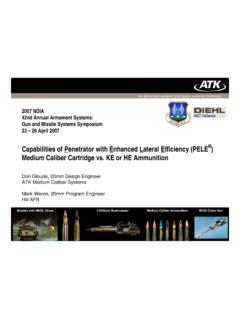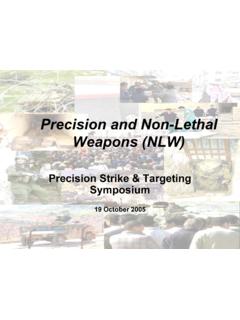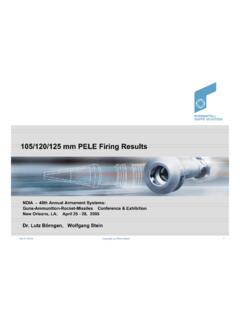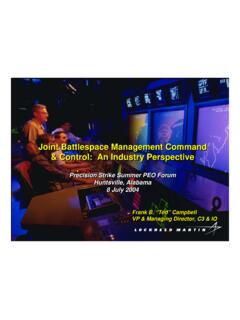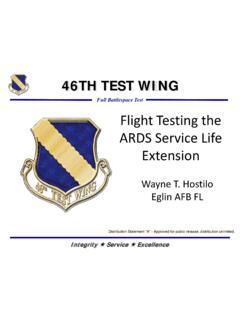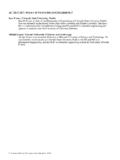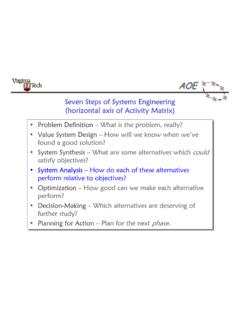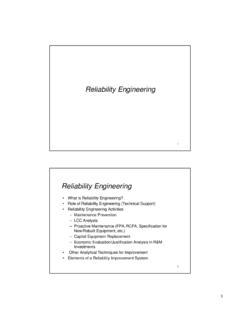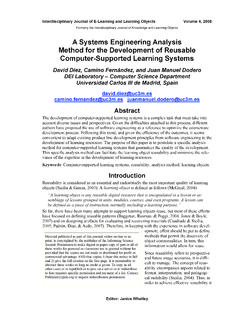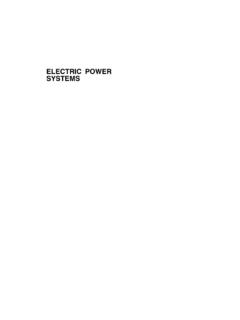Transcription of Systems Engineering Analysis of Threat Reduction Systems ...
1 Systems Engineering Analysis of Threat Reduction Systems Using a collaborative constructive simulation environment James E. Coolahan, L. West, G. Kovalchik, Hopkins University Applied Physics Laboratory11100 Johns Hopkins Road Laurel, MD 20723-6099240-228-5155, 240-228-8383, Systems Engineering ConferenceSan Diego, CAOctober 20-23, 2008 Andrew C. K. Wiedlea, Threat Reduction Agency8725 John J. Kingman Road Stop 6201 Fort Belvoir, VA Outline Threat Reduction Analytic Objectives Original Long-Term Vision for the constructive simulation environment Overview of Spiral Development / Analysis Approach Scenario Vignettes Nuclear Radiation Detection Modeling Behavior Module Characteristics Near-Term PlansThe work presented herein was supported by the Defense Threat Reduction Agency (DTRA) under NAVSEA Contract N00024-03-D-6606, Task SG412.
2 3 Threat Reduction Analytic ObjectivesIssues Many potential system solutions are being proposed for detection of materials important to Weapons of Mass Destruction (WMDs) system effectiveness evaluation requires Analysis of system performance in operationally realistic tactical vignettes Material detection effectiveness is an element of broader campaign-level scenariosOverall Analysis objective: To enable system acquisition decision-making by constructing an Analysis -of-alternatives capabilityImmediate Analysis objective Construct an Analysis -of-alternatives capability focused on detection of nuclear materials4 Original Long-Term Vision for the constructive simulation EnvironmentTools LayerResources LayerStakeholdersBattle ManagementNuclear/Rad DetectionProtection & MitigationTranslatorsLocal inputsUsers, Tools, and Resources Can Be Physically DistributedM&S Resource RepositoryScenario DatabasesEnvironmentDatabasesInfrastruct ure DatabasesSignature DataGeneral Use InformationM&S CatalogRelated DocumentsResource Interface Mechanisms (with Access Controls)
3 ISRI nterdiction DetectionPartnership EngagementForensicsSimulation InteroperabilityCommand & ControlInitial FocusSignature DataRelated DetectionForensicsSimulation Interoperability5 Overview of Spiral Development / Analysis Approach Spiral 0 (April - July 2007) Proof-of-concept use of Joint Semi-Automated Forces (JSAF) simulation for radiation detection in tactical vignette Spiral 1 (August 2007 January 2008) Setup of M&S laboratories at DTRA and JHU/APL Development of checkpoint scenario vignettes Development of higher fidelity JSAF radiation detection module and production of initial passive detection sensor performance Spiral 2 (February September 2008) Expansion of scenario vignettes, with 3D rendering Development of Behavior Module linked with JSAF Initial development of JSAF-embedded software for active concepts for nuclear material detection6 Spiral 0 Activities (April - July 2007) Evaluated several alternatives, and selected JSAF as simulation of choice to model tactical vignette in selected 100 x 100 mi.
4 Box Obtained / installed JSAF simulation Modified JSAF sensor module to model radiation detector Obtained terrain database for selected area Set up land bridge scenario vignette and checkpoint in JSAF Performed multiple JSAF executions to generate sensor performance estimates, including multi-sensor detections Tabulated sensor performance data in spreadsheet for use during table-top exercise7 Spiral 1 Activities (August 2007 January 2008) Conducted trade-off study to determine most effective configurations of dual DTRA and JHU/APL Systems Engineering M&S laboratories Procured hardware and software for both M&S laboratories Instantiated three land-based scenario vignettes for checkpoints in JSAF, consistent with accepted campaign-level scenario Developed higher fidelity radiation detector module for JSAF Performed multiple short JSAF executions to get (preliminary) performance curves for a variety of passive radiation sensor types8 Spiral 2 Activities (February September 2008)
5 Instantiated five additional scenario vignettes in JSAF Incorporated 3D rendering of vignettes using JStealth, federated with JSAF Improved JSAF passive radiation detection module Developed a JSAF module to model active concepts for nuclear material detection Performed additional JSAF runs to explore the performance of selected combinations of sensors and to produce inputs for Joint Analysis system (JAS) campaign-level simulation executions Incorporated intelligent behavior for red and blue assets in JSAF Federated new Behavior Module with JSAF, based on prior JHU/APL commander federate Independent Research and Development (IRAD) project Incorporated tactics based on discussions with subject matter experts Developed a secure shared repository containing scenario information, sensor characteristics, and performance results from simulation executions9 constructive simulation environment Progress Toward Long-Term VisionTools LayerResources LayerStakeholdersLocal inputsDTRA SE M&S Resource RepositoryGeneral Use InformationAs of Spiral 0 SensorCharacteristicsDocumentsJSAFC ultureSimRunTime InfrastructureScenarioTerrainJAST errain DatabaseScenario DatabaseAs of Spiral 1 simulation ResultsAs of Spiral 2 Behavior ModuleStakeholders (JHU/APL & DTRA)10 Scenario Vignettes (Three Types)
6 Land-based checkpoints to detect mobile nuclear material Rural / mountainous, limited road system Rural / flatland, broader road system Port area Land-based detection of stationary / hidden nuclear material Rural hideout Above-ground storage site Underground facility Detection of mobile nuclear material in maritime environment Straits Open water11 Nuclear Radiation Detection ModelingSource Signal to DetectorHighly Enriched UraniumRadiationShielding (Pb)Sgross (Gamma Radiation)Sensor Field of ViewDistance at Time (t)<NS,E>cylinderRadiation Spectra Present at Detector Faces(e,r) Fractional spectral density present at the detector face (function of energy & range)S(e,r) Spectrum present at detector face12 Sensor Model Input ConstantsSensor Model - Input ConstantsBgross= Gross background count (counts/sec) Assume constantProperties dependent on detector type:Asensor= projected surface area of detector [m2]FOV = field of view of sensor [deg]13 Sensor Model FunctionsSensor Model - FunctionsCalculate background signal, <NB, E> (assume constant Bgross)Calculate source signal, <NS, E>Calculate signal-to-noise ratio (SNR)Calculate detection probabilities, PD, PFAR andom draw for Detection Outcome14 JSAF Source-Sensor Model Data InteractionsJSAFS ensor ModelSimulation Object Model (SOM)Source ModelSgrossSgross, , V, rDetectionOutcomeWhere.
7 Sgross= Gross source count (counts/sec) = integration time interval (sec)V = Relative velocity of target (m/s)r = Range of target (m)and Detection Outcome can be one of:-No detection-Positive detection-False positive detection-Negative detection-False negative detection15 Sensor Signal-to-Noise Ratio vs. PD, PFA16 Nuclear Radiation Detection ModelingPhysics for Active DetectionMaterialsAttenuatorsStructuresT argetsShieldingAir, GraphiteIron, Steel, AluminumUranium (235, 238), Lead, Tungsten, Carbon, Calcium, SiliconIron, Lead, Wood, WaterDetectorGeV Proton BeamAttenuatorStructureTargetShielding17 Motivation for the Behavior ModuleIssue Standard scripting for Red and Blue CONOPS in scenario vignettes in JSAF attributed insufficient reactive behavior to humans involved For example, drivers of vehicles carrying nuclear materials simply proceeded to known checkpoints, were scanned, and detainedBehavior Module needed to Provide reactive CONOPS for Red and Blue assets, and background behaviors for Green entities Enable Analysis of effectiveness of Blue CONOPS using various sensors in opposition to Red CONOPS.
8 Together with Green background activity Enable trades between CONOPS and sensor investment decisions For example, given a sensor s maximum probability of detection, can an adjustment of resources to execute a CONOPS improve the ability to detect and interdict the nuclear material?18 Technology Basis for Behavior Module:Hybrid Reasoning Technology FrameworkKnowledgeBasePlannerDomain 1 PlannerDomain 1 PlannerDomain 1 PlannerDomain 1 Function approximation ClassificationCausal reasoningSolve new problems based on solutions of similar problemsExpert SystemCourse of actionAutomated-planning systemsPlannerDomain 1 PlannerDomain 1 PlannerDomain 1 Fuzzy Rule EngineDomain 1 CooperativeAgentsCooperativeAgentsCooper ativeAgentsPlannerDomain 1 PlannerDomain 1 PlannerDomain 1 NeuralNetworksDomain 2 PlannerDomain 1 PlannerDomain 1 PlannerDomain 1 BayesianNetworksDomain 5 PlannerDomain 1 PlannerDomain 1 PlannerDomain 1 Case-BasedReasoningDomain 1D1D2D519 Hybrid Reasoning FrameworkPreparation and Use Analyst gains
9 Understanding of the decision process to be simulated Analyst maps appropriate reasoning technologies to the decision process Analyst creates a domain-specific file using reasoning software GUI editor and exports the domain-specific file for agent s future use Agents load domain-specific files as needed for their function, provide problem specific inputs (state), and use appropriate generic engines to create solution outputsAnalystAgentGenerateDomain FilewithGUIS olution OutputsGeneric Reasoning EngineDomain FileStateUnderstandand Map DecisionProcess to Technologies20 Baseline Concept for Enhanced Checkpoint Scenario Vignette Using Behavior ModuleMobile SensorGreen Pool21 Behavior ModuleCurrent Blue Checkpoint BehaviorsWhen a Red or green vehicle reaches a checkpoint, a roadblock prevents passage in one direction until the sensor reports If the reading is negative, the roadblock raises and allows the vehicle to pass If the reading is positive.
10 The vehicle is sent to a quarantine location A mobile sensor platform is tasked to report to the quarantine location to conduct a second reading If the second reading is negative, the vehicle is allowed to continue its journey If the second reading is positive, the vehicle is sent to a holding location. Blue adjusts the roadblock to manage the length of the traffic backup Certain types of vehicles are randomly selected for checks. If the checkpoint queue gets too long, Blue communicates to the Blue selection point in order to reduce the percentage selected until the queue length is ModuleCurrent Red Checkpoint Behaviors Red vehicle starts at safe house and travels to destination over existing roads Red vehicle is informed by a Red scout
